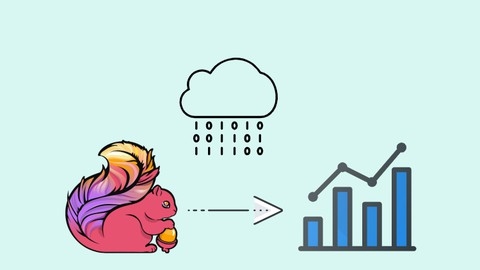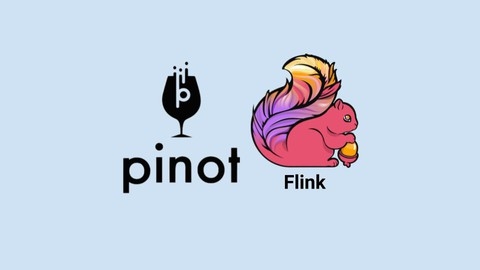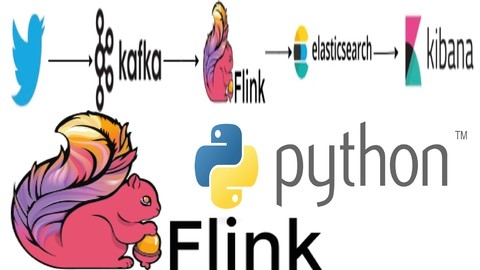Apache Flink is an open-source stream processing framework designed for real-time data analysis.
It’s a powerful tool for applications like fraud detection, event tracking, and real-time dashboards, and learning it can open doors to exciting career opportunities in big data and data science.
With Flink’s ability to process massive amounts of data in real-time, you can gain valuable insights from your data streams and make data-driven decisions quickly.
Finding a high-quality Apache Flink course on Udemy can be challenging, especially with so many options available.
You’re looking for a course that is both comprehensive and engaging, with experienced instructors who can guide you through the complexities of Flink and its various APIs.
We’ve carefully analyzed numerous Udemy courses and have identified Apache Flink | A Real Time & Hands-On course on Flink as the best overall course.
This comprehensive program stands out for its focus on practical applications, guiding you through hands-on exercises and real-world projects.
The instructor provides clear explanations, making it suitable for both beginners and those with some prior experience.
While this is our top pick, there are other excellent Apache Flink courses available on Udemy.
Keep reading to explore our recommendations for different learning styles and specific areas of focus, including courses tailored to specific Flink APIs and integration with other technologies.
Apache Flink | A Real Time & Hands-On course on Flink
This course provides a robust introduction to Apache Flink.
You’ll begin by understanding Flink’s architecture and its place in the world of stream processing, comparing it to other popular frameworks like Spark.
You’ll learn to code in both the DataSet API and DataStream API, mastering essential operations like word counting and manipulating data in a real-time setting.
You’ll also explore the concept of joins, enabling you to combine data from different sources for richer insights.
The section on Windows is particularly noteworthy.
You’ll discover how to analyze data within specific time frames, such as every minute, and even handle situations where data arrives out of order.
You’ll dive into various window types, including tumbling, sliding, and session windows, gaining practical skills for real-time analysis.
The course delves deeper into state management, a crucial aspect of reliable real-time processing.
You’ll learn about checkpoints and state backends, ensuring your Flink programs are robust and fault-tolerant.
You’ll explore different state implementations, including value state, list state, and reducing state, as well as more advanced techniques like broadcast state and queryable state.
You’ll then learn how to integrate Kafka into your Flink applications, allowing you to process real-time data streams from Kafka.
The course provides practical case studies to solidify your understanding, including Twitter data analysis, real-time fraud detection for a bank, and building a real-time stock trading system.
Finally, you’ll explore the Table API and SQL API, which enable you to query your data using a relational database approach.
Throughout the course, quizzes and case studies provide hands-on practice, ensuring you gain confidence in building your own real-time data applications.
You’ll also gain a solid foundation in graph processing using the Gelly API, allowing you to work with connected data.
Learn By Example : Apache Flink
You’ll embark on a journey that starts with the fundamentals, exploring the differences between stream processing and batch processing before delving into Flink’s architecture.
The hands-on approach will guide you through installation and setup, culminating in the creation of your first Flink program – the classic “Hello World!”
The course truly shines as you explore the DataStream API, a powerful toolkit for manipulating data streams.
You’ll gain proficiency in applying transformations like filter, map, flatMap, and reduce, and master the art of working with keyed streams, where you can perform operations on specific data elements.
You’ll then delve into the world of window operations, processing data in chunks using techniques like tumbling, sliding, count, and session windows.
The course explores the intricacies of time and how to implement custom window functions, even providing real-world examples like Twitter streaming data analysis to solidify your understanding.
Beyond stream processing, the course also addresses fault tolerance with state and checkpointing, ensuring your Flink applications are resilient to failures.
You’ll explore working with multiple streams, applying operations like unions, joins, coGroups, and coMaps.
The DataSet API is also covered, providing you with tools for batch processing in Flink.
You’ll learn to apply transformations on data sets and utilize Flink-ML for machine learning tasks.
The course delves into the world of graph data with Gelly, teaching you how to represent and analyze complex relationships.
While the course provides a thorough introduction to Flink, you might want to consider whether its level of depth aligns with your specific learning goals.
If you’re seeking advanced concepts and niche applications, this course might serve as a solid foundation for further exploration.
Apache Flink Relational Programming using Table API and SQL
You’ll learn to leverage the flexibility of the Table API and SQL Interface, making it easy to write efficient data processing code.
The course guides you through building different types of tables, including CSV files, Kafka integrations, and even hardcoded data for experimentation.
You’ll master the use of the TableEnvironment to manipulate data within your tables, performing operations like selecting, filtering, joining, and aggregating data.
The course delves into the intricacies of stream processing using Flink, emphasizing the critical role of time in your data analysis.
You’ll explore various windowing techniques for analyzing streaming data, including tumbling windows, sliding windows, and session windows.
You’ll gain hands-on experience applying these techniques using both the Table API and SQL, mastering event time processing for accurate analysis.
Finally, you’ll learn about user-defined functions (UDFs), allowing you to create custom logic tailored to your data processing needs.
Fundamentals of Apache Flink
This course begins by laying out the basics, defining Flink and its role in the big data landscape.
You’ll quickly move into hands-on exercises, setting up Flink on your local machine and then on AWS, giving you experience in both environments.
The course does a great job of guiding you through Flink’s Cluster UI, the essential tool for managing and monitoring your Flink jobs.
You’ll gain a strong understanding of Flink’s programming model, the difference between batch and stream processing, and how to choose the right approach for your data needs.
The core of the course delves into the practicalities of both batch and stream processing.
You’ll learn to load data into Flink from various sources, manipulate it through transformations (filtering, projections, etc.), and aggregate it to reveal meaningful insights.
The course goes beyond the basics, covering advanced concepts like partitioning and joins, ensuring you can effectively handle complex datasets.
Finally, you’ll explore the intricacies of stream processing, including windowing operations, time characteristics, and state management.
This comprehensive approach leaves you well-prepared to tackle real-world data processing challenges with Apache Flink.
Apache Flink 101 Developer Course Formula- PyFlink Hands On
“Apache Flink 101 Developer Course Formula- PyFlink Hands On” is a comprehensive guide to the world of big data processing with Apache Flink, specifically utilizing PyFlink, Python’s powerful integration with Flink.
You’ll start by diving into Flink’s architecture, gaining a solid understanding of its inner workings, before delving into Flink’s APIs, the tools that will become your building blocks for creating applications.
The course provides a clear comparison of Flink and Spark, two prominent big data processing engines, giving you the foundation to make informed decisions when choosing the right tool for your projects.
You’ll then embark on a guided installation process, setting up both Apache Flink and the essential Python environment, including PyFlink.
From there, you’ll dive deep into the heart of PyFlink, mastering the Table API, Flink’s powerful tool for querying and manipulating data.
You’ll learn to create tables from various data sources, write complex queries using both the Table API and SQL, and even seamlessly mix the two for maximum flexibility.
The course goes beyond the basics, demonstrating how to integrate Flink with Kafka, a widely used streaming platform, allowing you to build real-time data pipelines.
You’ll learn to read data from Kafka, process it using Flink, and then write the processed results to Elasticsearch, making visualization with Kibana a breeze.
To solidify your understanding and gain practical experience, you’ll build a real-world streaming project.
This project will involve extracting data from the Twitter API, processing it using Flink, and finally storing it in Elasticsearch.
This hands-on experience will solidify your understanding of the concepts and provide you with valuable, in-demand skills.
The course concludes with a focus on stateful stream processing, exploring how Flink manages data changes over time and the essential concepts of dataflow and snapshots.
This prepares you for the Certified Apache Flink Mastery Award Exam, with included practice tests to boost your confidence for real-world Flink certification.
Apache Flink with Scala 3
You’ll embark on a journey that delves deep into the core functionalities of Flink, starting with its underlying architecture and principles.
Prepare to gain hands-on experience extracting data from a variety of sources, including the widely-used Kafka platform.
You’ll master the art of data transformation with Flink’s low-level APIs, learning to manipulate data streams and implement complex processing logic.
The course then guides you through advanced concepts like timely streaming and windowing, enabling you to handle time-based events and manage stateful operations with confidence.
This course focuses on practical application, providing you with the skills to tackle real-world data streaming challenges and leverage Flink’s power in your own projects.
Realtime Analytics with Apache Pinot and Apache Flink
You’ll journey through the world of streaming data, mastering powerful tools like Apache Kafka, Apache Flink, Apache Pinot, and Apache Superset.
Starting with a clear understanding of why real-time analytics is crucial, you’ll dive into a practical business case focused on an online cab service.
This hands-on approach allows you to build a data model that supports real-time insights.
You’ll then master Apache Kafka, learning how to ingest and process streaming data with hands-on setup and data production/consumption exercises.
Next, you’ll explore Apache Flink, delving into the Table API and Flink SQL to transform and analyze your data in real time.
You’ll master essential concepts like checkpoints, watermarks, and different types of joins to enrich your data with external sources like MySQL.
The course then introduces Apache Pinot, a high-performance real-time data store.
You’ll set it up and learn how to perform real-time ingestion and upserts, exploring querying data through the Pinot Data Explorer and REST API.
Finally, you’ll use Apache Superset to create interactive dashboards, visualizing your real-time insights.
You’ll gain practical experience with these powerful tools, allowing you to extract valuable insights from your data in real time.
Apache Flink & Kafka End-to-end Streaming Project Hands-on
This course offers a deep dive into the world of real-time data processing, equipping you with the skills and knowledge to build robust streaming pipelines.
You’ll gain hands-on experience with critical technologies like Kafka, Apache Flink, Elasticsearch, and Kibana, learning how to capture, process, and analyze live data from sources like Twitter.
The course starts by guiding you through the process of using the Twitter API and Python to grab data and send it to Hadoop HDFS via Kafka.
You’ll set up a Kafka Producer to send data and a Kafka Consumer to receive it, mastering the fundamentals of this powerful data streaming tool.
Next, you’ll delve into Apache Flink, a powerful tool for real-time data processing.
You’ll use it to process Twitter data from Kafka and then send the results to Elasticsearch, a powerful search engine, and Kibana, a tool for visualizing data.
This will allow you to create a data pipeline capable of handling massive volumes of real-time data.
Throughout the course, you’ll engage with PyFlink, a Python library for working with Apache Flink.
You’ll learn how to use it to process and analyze data, gaining a valuable understanding of its capabilities and how it compares to other popular tools like Spark.
This course provides a practical and hands-on approach to learning these critical technologies.
You’ll gain valuable insights into a real-world streaming project, equipping you with the skills needed to confidently tackle complex data processing challenges.
Apache Flink Videocourse: Learn The Essentials
You’ll begin by diving into the heart of Flink’s capabilities, understanding how it handles unbounded data streams, those continuous flows of information that are crucial for real-time applications.
You’ll gain a deep understanding of time and state within the context of stream processing – concepts that are fundamental for making sense of data as it arrives.
The course will explore the motivations behind choosing Flink, highlighting its advantages for handling massive amounts of data in real-time.
You’ll then delve into the core of Flink’s framework, learning about its powerful schedulers and exploring how data flows through streams.
You’ll learn about the concept of forward and learning, which are key to understanding how Flink efficiently processes data and continuously improves its performance.
This course provides a strong introduction to the core concepts and mechanisms of Apache Flink, equipping you with a foundational understanding of this powerful tool for real-time data processing.









